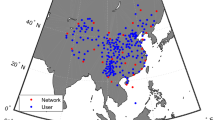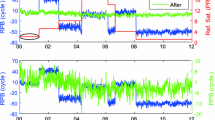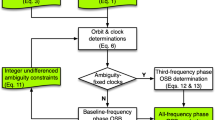Abstract
Ambiguity resolution (AR) in precise point positioning (PPP) requires precise satellite orbit, clocks, and phase biases corrections. Satellite phase biases are fractional hardware corrections which help to retrieve the un-differenced integer carrier phase ambiguities. Satellite corrections can be obtained from the international GNSS service (IGS) or estimated by correction providers called producer-side. We introduce a new PPP-AR observation model and a new sequential network algorithm (SNA) to estimate satellite phase biases. The new model is fully compatible with standard IGS satellite correction products, and it takes advantage of currently available IGS global ionosphere maps to improve the stability of corrections estimation. Furthermore, the proposed model is full-rank per-frequency and per-site and this method simplifies the integration of any additional frequency or site observables in the system of equations. The per-site satellite phase biases method allows users to customize their network solution. In many cases, users only have to estimate the phase biases of a few satellites estimated by few stations to resolve ambiguities of their observed satellites. The novel two-step algorithm provides a good balance between the computational burden, the computer memory load, the efficiency of handling parameters, and the precise estimation of correction parameters. The proposed PPP-AR model and the SNA performance is then validated by estimating satellite phase biases with 1 year of GPS data from a sub-network of IGS stations. A rigorous a posteriori statistical test is performed using data from an independent GPS network. As a result, the precision of WL and L1 ambiguities was improved significantly with the confidence level of P > 99.99% by applying the estimated phase bias corrections to phase observables.





Similar content being viewed by others
References
Banville S, Langley RB (2010) Instantaneous cycle-slip correction for real-time PPP applications. Navigation 57(4):325–334. https://doi.org/10.1002/j.2161-4296.2010.tb01786.x
Banville S, Collins P, Zhang W, Langley RB (2014) Global and regional ionospheric corrections for faster PPP convergence. Navigation 61(2):115–124. https://doi.org/10.1002/navi.57
Bertiger W, Desai SD, Haines B, Harvey N, Moore AW (2010) Single receiver phase ambiguity resolution with GPS data. J Geodesy 84(5):327–337. https://doi.org/10.1007/s00190-010-0371-9
Blewitt G (1989) Carrier phase ambiguity resolution for the Global Positioning System applied to geodetic baselines up to 2000 km. J Geophys Res 94(B8):10187–10203. https://doi.org/10.1029/JB094iB08p10187
Boehm J, Heinkelmann R, Schuh H (2007) Short note: a global model of pressure and temperature for geodetic applications. J Geodesy 81(10):679–683. https://doi.org/10.1007/s00190-007-0135-3
Choy S, Bisnath S, Rizos C (2017) Uncovering common misconceptions in GNSS precise point positioning and its future prospect. GPS Solut 21(1):13–22. https://doi.org/10.1007/s10291-016-0545-x
Cocard M, Bourgon S, Kamali O, Collins P (2008) A systematic investigation of optimal carrier-phase combinations for modernized triple-frequency GPS. J Geodesy 82(9):555–564. https://doi.org/10.1007/s00190-007-0201-x
Collins P, Bisnath S (2011) Issues in ambiguity resolution for Precise Point Positioning. In: Proceeding of the ION GNSS 2011, Institute of Navigation, Portland, OR, USA, September 20–23, pp 679–687
Collins P, Bisnath S, Lahaye F, Héroux P (2010) Undifferenced GPS ambiguity resolution using the decoupled clock model and ambiguity datum fixing. Navigation 57(2):123–135. https://doi.org/10.1002/j.2161-4296.2010.tb01772.x
Dong D, Bock Y (1989) Global positioning system network analysis with phase ambiguity resolution applied to crustal deformation studies in California. J Geophys Res 94(B4):3949. https://doi.org/10.1029/JB094iB04p03949
Ge M, Gendt G, Rothacher M, Shi C, Liu J (2008) Resolution of GPS carrier-phase ambiguities in Precise Point Positioning (PPP) with daily observations. J Geodesy 82(7):389–399. https://doi.org/10.1007/s00190-007-0187-4
Geng J, Shi C (2017) Rapid initialization of real-time PPP by resolving undifferenced GPS and GLONASS ambiguities simultaneously. J Geodesy 91(4):361–374. https://doi.org/10.1007/s00190-016-0969-7
Geng J, Meng X, Dodson AH, Ge M, Teferle FN (2010a) Rapid re-convergences to ambiguity-fixed solutions in precise point positioning. J Geodesy 84(12):705–714. https://doi.org/10.1007/s00190-010-0404-4
Geng J, Meng X, Dodson AH, Teferle FN (2010b) Integer ambiguity resolution in precise point positioning: method comparison. J Geodesy 84(9):569–581. https://doi.org/10.1007/s00190-010-0399-x
Geng J, Teferle FN, Meng X, Dodson AH (2011) Towards PPP-RTK: ambiguity resolution in real-time precise point positioning. Adv Space Res 47(10):1664–1673. https://doi.org/10.1016/j.asr.2010.03.030
Geng J, Shi C, Ge M, Dodson AH, Lou Y (2012) Improving the estimation of fractional-cycle biases for ambiguity resolution in precise point positioning. J Geodesy 86(8):579–589. https://doi.org/10.1007/s00190-011-0537-0
Henkel P, Günther C (2010) Partial integer decorrelation: optimum trade-off between variance reduction and bias amplification. J Geodesy 84(1):51–63. https://doi.org/10.1007/s00190-009-0343-0
Héroux P, Gao Y, Kouba J, Lahaye F (2004) Products and applications for Precise Point Positioning-Moving towards real-time. In: Proceedings of the ION ITM 2004, Institute of Navigation, Long Beach, CA, USA, September 21–24, pp 1832–1843
Juan JM, Hernández-Pajares M, Sanz J, Ramos-Bosch P, Aragón-Àngel À, Orús R (2012) Enhanced precise point positioning for GNSS users. IEEE Trans Geosci Remote Sens 50(10):4213–4222. https://doi.org/10.1109/tgrs.2012.2189888
Kouba J (2002) Relativistic time transformations in GPS. GPS Solut 5(4):1–9. https://doi.org/10.1007/PL00012907
Lagler K, Schindelegger M, Bohm J, Krasna H, Nilsson T (2013) GPT2: empirical slant delay model for radio space geodetic techniques. Geophys Res Lett 40(6):1069–1073. https://doi.org/10.1002/grl.50288
Laurichesse D, Mercier F (2007) Integer ambiguity resolution on undifferenced GPS phase measurements and its application to PPP. In: Proceedings of the ION ITM 2007, Institue Of Navigation, Fort Worth, TX, USA, September 25–28, pp 839–848
Laurichesse D, Privat A (2015) An Open-source PPP client implementation for the CNES PPP-WIZARD demonstrator. In: Proceedings of the ION ITM 2015, Institute Of Navigation, Tampa, Florida, USA, September 14–18, pp 2780–2789
Laurichesse D, Cerri L, Berthias J-P, Mercier F (2013) Real time precise GPS constellation and clocks estimation by means of a Kalman filter. In: Proceedings of the ION GNSS 2013, Institute of Navigation, Nashville, TN, USA, 16–20 September, 1155–1163
Li X, Zhang X, Ge M (2011) Regional reference network augmented precise point positioning for instantaneous ambiguity resolution. J Geodesy 85(3):151–158. https://doi.org/10.1007/s00190-010-0424-0
Li X, Ge M, Zhang H, Wickert J (2013) A method for improving uncalibrated phase delay estimation and ambiguity-fixing in real-time precise point positioning. J Geodesy 87(5):405–416. https://doi.org/10.1007/s00190-013-0611-x
Li X, Ge M, Dai X, Ren X, Fritsche M, Wickert J, Schuh H (2015) Accuracy and reliability of multi-GNSS real-time precise positioning: GPS, GLONASS, BeiDou, and Galileo. J Geodesy 89(6):607–635. https://doi.org/10.1007/s00190-015-0802-8
Paziewski J, Wielgosz P (2015) Accounting for Galileo–GPS inter-system biases in precise satellite positioning. J Geodesy 89(1):81–93. https://doi.org/10.1007/s00190-014-0763-3
Petit G, Luzum B (2010) IERS conventions. IERS Technical Note 36, Verlag des Bundesamt für Kartographie und Geodäsie, Frankfurt am Main, Germany, http://www.iers.org/TN36/
Seepersad G, Bisnath S (2015) Examining the interoperability of PPP-AR products. In: Proceedings of the ION ITM 2015, Institute Of Navigation, Tampa, Florida, USA, September 14–18, pp 2845–2857
Shi J, Gao Y (2014) A comparison of three PPP integer ambiguity resolution methods. GPS Solut 18(4):519–528. https://doi.org/10.1007/s10291-013-0348-2
Tariku Y (2015) Patterns of GPS-TEC variation over low-latitude regions (African sector) during the deep solar minimum (2008 to 2009) and solar maximum (2012 to 2013) phases. Earth, Planets Space 67(1):35. https://doi.org/10.1186/s40623-015-0206-2
Teunissen PJG (1995) The least-squares ambiguity decorrelation adjustment: a method for fast GPS integer ambiguity estimation. J Geodesy 70(1–2):65–82. https://doi.org/10.1007/BF00863419
Teunissen PJG (1998) Success probability of integer GPS ambiguity rounding and bootstrapping. J Geodesy 72(10):606–612. https://doi.org/10.1007/s001900050199
Teunissen PJG, Khodabandeh A (2015) Review and principles of PPP-RTK methods. J Geodesy 89(3):217–240. https://doi.org/10.1007/s00190-014-0771-3
Verhagen S (2004) Integer ambiguity validation: an open problem? GPS Solut 8(1):36–43. https://doi.org/10.1007/s10291-004-0087-5
Wu JT, Wu SC, Hajj GA, Bertiger W, Lichten SM (1992) Effects of antenna orientation on GPS carrier phase. Adv Astronaut Sci 76(2):1647–1660
Wübbena G, Schmitz M, Bagge A (2005) PPP-RTK : precise point positioning using state-space representation in RTK networks. In: Proceedings of the ION ITM 2005, Institute Of Navigation, Long Beach, CA, USA, September 13–16, pp 2584–2594
Zhang X, Li X (2012) Instantaneous re-initialization in real-time kinematic PPP with cycle slip fixing. GPS Solut 16(3):315–327. https://doi.org/10.1007/s10291-011-0233-9
Zhang X, Li P (2013) Assessment of correct fixing rate for precise point positioning ambiguity resolution on a global scale. J Geodesy 87(6):579–589. https://doi.org/10.1007/s00190-013-0632-5
Zhang B, Teunissen PJG, Odijk D (2011) A novel un-differenced PPP-RTK concept. J Navig 64(S1):180–191. https://doi.org/10.1017/S0373463311000361
Zou X, Tang W, Shi C, Liu J (2015) Instantaneous ambiguity resolution for URTK and its seamless transition with PPP-AR. GPS Solut 19(4):559–567. https://doi.org/10.1007/s10291-014-0411-7
Zumberge JF, Heflin MB, Jefferson DC, Hefkins MM, Webb FH (1997) Precise point positioning for the efficient and robust analysis of GPS data from large networks. J Geophys Res 102(B3):5005–5017. https://doi.org/10.1029/96JB03860
Acknowledgements
Several organizations have contributed to financing this research: The Canadian GEOIDE (GEOmatics for Informed DEcisions) Network phase III, the Natural Sciences and Engineering Research Council of Canada (NSERC) attributed to Rock Santerre, Fond de soutien de Faculté de Foresterie, de Géographie et de Géomatique (FFGG) from Laval University, and Centre de Recherche en Géomatique (CRG-REGARD Laboratory) for the access to their computer cluster. All these supports are gratefully acknowledged. The authors also acknowledge the availability of IGS data and products to this research, which is the result of the efforts of individuals and organizations that provide an invaluable service to the scientific and professional communities. Thanks to Ken MacLeod for proofreading this article.
Author information
Authors and Affiliations
Corresponding author
Rights and permissions
About this article
Cite this article
Kamali, O., Cocard, M. & Santerre, R. A sequential network approach for estimating GPS satellite phase biases at the PPP-AR producer-side. GPS Solut 22, 59 (2018). https://doi.org/10.1007/s10291-018-0724-z
Received:
Accepted:
Published:
DOI: https://doi.org/10.1007/s10291-018-0724-z




